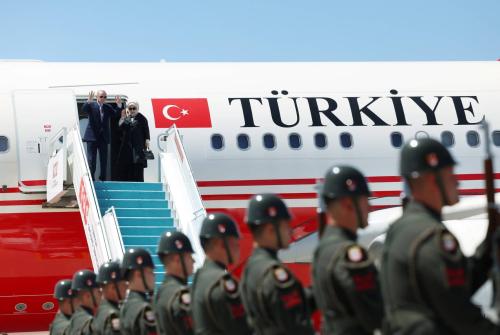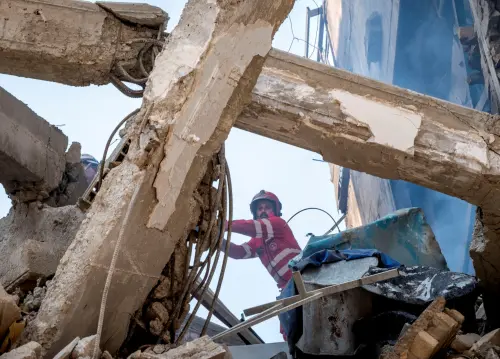Little is going well in U.S.-Russia relations right now. Russia’s military aggression against Ukraine, major differences over Syria, and the more bellicose tone coming out of the Kremlin have helped drag the bilateral relationship to its lowest point since the 1991 collapse of the Soviet Union.
A bright spot
One of the few bright spots is the New Strategic Arms Reduction Treaty (New START). Signed by Presidents Barack Obama and Dmitry Medvedev on April 8, 2010, the treaty entered into force on February 5, 2011. This Friday, February 5 will mark the end of the fifth year of the treaty’s implementation.
New START requires that, by February 5, 2018, the United States and Russia each reduce their strategic offensive forces to no more than 1,550 deployed strategic warheads on no more than 700 deployed intercontinental ballistic missiles (ICBMs), submarine-launched ballistic missiles (SLBMs), and nuclear-capable bombers. In addition, each side is limited to no more than 800 deployed and non-deployed ICBM and SLBM launchers and nuclear-capable bombers.
Treaty implementation seems to be proceeding smoothly. As of September 1, 2015 (the date of the most recent semi-annual data exchange required by the treaty), the United States had 1,538 deployed strategic warheads on 762 deployed ICBMs, SLBMs, and nuclear-capable bombers. The Russian numbers were 1,648 deployed strategic warheads and 526 deployed strategic missiles and nuclear-capable bombers.
| New START Limit | United States | Russia |
| Deployed SDVs (700) | 762 | 526 |
| Deployed warheads (1,550) | 1,538 | 1,648 |
(Limits take full effect in February 2018)
Beyond the regular data exchanges, New START requires that each side notify the other of certain types of changes to its strategic forces and other activities concerning them. As of late January, the sides had made over 10,200 treaty-required notifications.
New START also permits each side to carry out 18 inspections per year of the strategic forces of the other. Both fully used their inspection quotas in the first four treaty years and, as of late January, each had carried out all 18 of its allowed inspections in the fifth treaty year.
New START’s value
New START was concluded at a more promising time in the bilateral relationship. In 2010, the Obama administration’s reset policy was paying off, not just with a new nuclear arms reduction agreement, but also in terms of greater Russian cooperation in preventing an Iranian nuclear weapons program and facilitating support for American and coalition military forces operating in Afghanistan. Unfortunately, the relationship took a tumble in 2011 and 2012, when Vladimir Putin returned to the Russian presidency. The decline in relations accelerated when Russia seized and illegally annexed Crimea, and then supported armed separatism in Eastern Ukraine.
Today, with increased tension in the bilateral relationship and American and Russian military units more frequently operating in close proximity to one another, New START’s limits and transparency measures are proving more valuable. First of all, each side has accepted that its overall strategic nuclear potential will be reduced and capped in a verifiable manner. That bounds and stabilizes a key area of their military competition.
Today, with increased tension in the bilateral relationship and American and Russian military units more frequently operating in close proximity to one another, New START’s limits and transparency measures are proving more valuable.
Second, New START’s transparency and verification measures—including semi-annual data exchanges, notifications, and inspections—give each side far more information about the other’s strategic forces than it would otherwise have. For example, every time a U.S. team carries out an inspection at a Russian ICBM base, it receives a list showing all deployed ICBMs at the base, their location, and the number of warheads on each individual ICBM—information that would be extremely difficult to get without Russian cooperation under New START.
Absent such transparency, the Pentagon would have to make more worst-case assumptions about Russian strategic forces and intentions, particularly given the current tension between Washington and Moscow. This would increase the likelihood of miscalculation on both sides. A lack of transparency could drive the U.S. military to take unnecessary steps in its strategic force operations—unnecessary steps that could seem provocative to Moscow and cause the Russians to take additional steps of their own. There is a reason why the Joint Chiefs of Staff so highly value New START’s transparency provisions.
What next?
In contrast to the 1987 Intermediate-Range Nuclear Forces (INF) Treaty, which Russia has violated by testing a ground-launched cruise missile to intermediate range, Moscow by all appearances remains interested in maintaining New START’s limits. Continuing to observe New START is in the U.S. interest despite the INF compliance issue.
In 2013, President Obama proposed to reduce the limit of 1,550 deployed warheads by up to one-third, and U.S. officials indicated that Washington was prepared to make commensurate reductions in the treaty’s other limits. Moscow did not pick up on that proposal. Russian officials have said that they will not consider further reductions until New START is fully implemented. Instead, they have pressed to address other issues, such as missile defense and advanced conventional strike weapons. Significant new negotiated reductions will require that the sides find a way to bridge the differences between their approaches, as well as an improved political climate.
Whether or not Moscow will be prepared to discuss further reductions after New START’s limits are fully implemented in February 2018 remains to be seen. Given the difficulties between the two countries, one should keep expectations modest. Both sides, however, should continue to see the value in observing New START.
For a broader look at the current state of nuclear arms control, see the Brookings Arms Control and Non-Proliferation Initiative’s PowerPoint presentation, “Nuclear Arms Control in 2016.”
The Brookings Institution is committed to quality, independence, and impact.
We are supported by a diverse array of funders. In line with our values and policies, each Brookings publication represents the sole views of its author(s).




Commentary
New START turns five
February 4, 2016